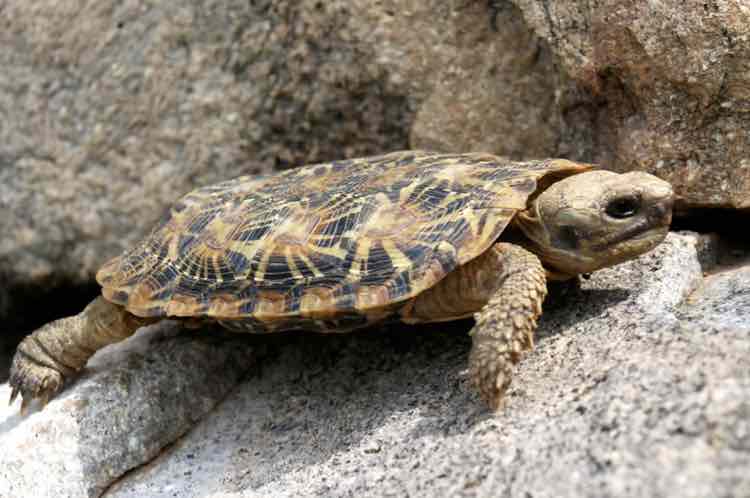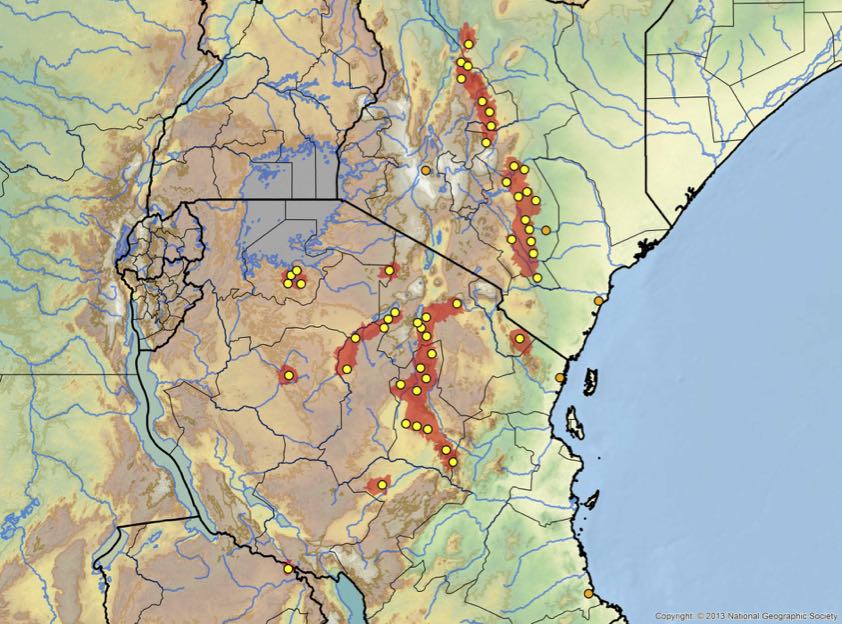Malacochersus tornieri, 107
Download pdf
Malacochersus tornieri (Siebenrock 1903) –
Pancake Tortoise, Tornier’s Tortoise, Soft-shelled Tortoise, Crevice Tortoise,
Kobe Ya Mawe, Kobe Kama Chapati
Reginald T. Mwaya1, Don Moll2,
Patrick Kinyatta Malonza3, and Jacob Mueti Ngwava3
1College of African Wildlife Management, Mweka,
3Section of Herpetology, National Museums of Kenya, P.O. Box 40658-00100, Nairobi, Kenya
Summary. – The Pancake Tortoise, Malacochersus tornieri (family Testudinidae), is a small, flat, and soft tortoise of up to about 17.8 cm carapace length, rarely weighing more than 500 g. It has a flat and pliable shell resulting from limited bony shell development with a covering of thin keratinous scutes. The flat shape and shell pliability are fundamental adaptations which have enabled the species to successfully utilize rock crevice microhabitats in East Africa. The species occurs widely but disjunctly in Kenya and Tanzania, and marginally in northern Zambia. It is associated with isolated rocky hills and outcrops (kopjes) within its range, where it hides in crevices between and under exfoliating slabs of pre-Cambrian rock (gneiss). Sexual maturity is reached at the age of 5–9 years, depending on sex and growth rate, and a life span of over 25 years in captivity has been reported. Normally only one egg is laid annually, and rarely two per clutch. The status of M. tornieri populations in the wild indicates that abundance varies from one area to another and appears to be a function of microhabitat quality and level of local exploitation. The listing of the species on CITES Appendix II, while helpful, has also added to human overexploitation abuse, as it stimulated illegal off-take to supply the international live animal trade. In 2000, a proposal to uplist the Pancake Tortoise from CITES Appendix II to Appendix I was unsuccessful, but is again being reconsidered. In Tanzania, a zero export quota for wild-caught animals and restrictions on the size and number of captive-produced juveniles that could be exported were retained. The proposal to uplist the species to CITES Appendix I is strongly recommended. The species is highly vulnerable to extinction by virtue of its restricted distribution, specialized habitat requirements, low densities and fragmented populations, reduced reproductive potential, and overexploitation for the international live animal trade.
Distribution. – Kenya, Tanzania, Zambia. Occurs disjunctly from north central Kenya southward into the southeastern part of the country. In Tanzania it occurs disjunctly from the southern shores of Lake Victoria into the Maasai Steppe and further south in the Somalia-Masai and the Zambesian Floristic Regions. In Zambia it has only been reported from a single site in northern Nakonde District.
Synonymy. – Testudo tornieri Siebenrock 1903, Testudo (Malacochersus) tornieri, Malacochersus tornieri, Testudo loveridgii Boulenger 1920.
Subspecies. – None currently recognized.
Citation:
Mwaya, R.T., Moll, D., Malonza, P.K., and Ngwava, J.M. 2018. Malacochersus tornieri (Siebenrock 1903) – Pancake Tortoise, Tornier’s Tortoise, Soft-shelled Tortoise, Crevice Tortoise, Kobe Ya Mawe, Kobe Kama Chapati. In: Rhodin, A.G.J., Iverson, J.B., van Dijk, P.P., Stanford, C.B., Goode, E.V., Buhlmann, K.A., Pritchard, P.C.H., and Mittermeier, R.A. (Eds.). Conservation Biology of Freshwater Turtles and Tortoises: A Compilation Project of the IUCN/SSC Tortoise and Freshwater Turtle Specialist Group. Chelonian Research Monographs 5(12):107.1–15. doi: 10.3854/crm.5.107.tornieri.v1.2018; iucn-tftsg.org/cbftt/.
Download pdf
(Adobe Acrobat 6.0 or later required)

Malacochersus tornieri in its habitat outside a crevice, Ruaha National Park, Tanzania.
Photo by F. Schmidt.
Distribution:

Distribution of Malacochersus tornieri in East Africa in Kenya, Tanzania, and northern Zambia. Yellow dots = museum and literature occurrence records of native populations based on Iverson (1992) plus more recent and authors’ data; orange dots = uncertain native or trade or introduced specimens; red shading = projected historic distribution. Distribution based on GIS-defined level 12 HUCs (hydrologic unit compartments) constructed around verified localities and then adding HUCs that connect known point localities in the same watershed or physiographic region, and similar habitats and elevations as verified HUCs (Buhlmann et al. 2009; TTWG 2017), and adjusted based on authors’ subsequent data.










